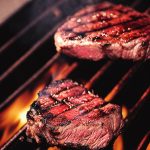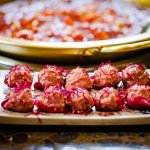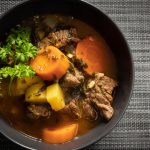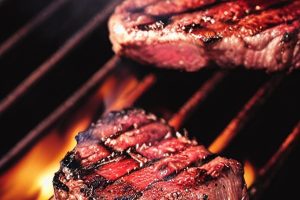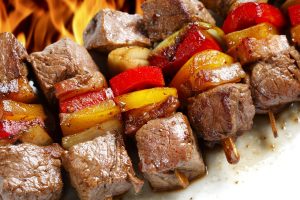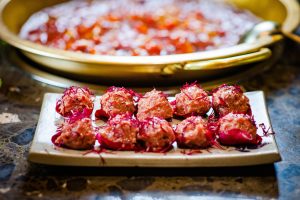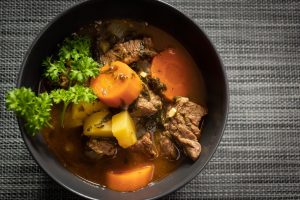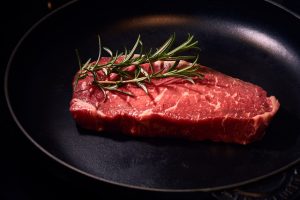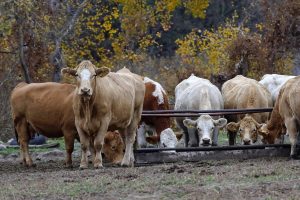The Origins of Moo Shu Beef: Tracing its Roots to Imperial China
Moo Shu Beef is a popular dish in Chinese cuisine that has gained international recognition for its unique flavors and presentation. The origins of this delectable dish can be traced back to Imperial China, where it was originally created and enjoyed by the aristocracy. Let us delve into the history of Moo Shu Beef and explore its roots in the imperial courts.
During the Ming Dynasty (1368-1644), the imperial court was known for its lavish banquets and the refinement of its culinary arts. It was during this time that the concept of Moo Shu Beef was developed. The dish was initially prepared using thinly sliced beef, which was stir-fried with a variety of vegetables and seasonings. The inclusion of mushrooms, wood ear fungus, and bamboo shoots added depth and texture to the dish, creating a harmonious blend of flavors.
The name “Moo Shu” itself is derived from the Mandarin word “mù xū,” which translates to “wood shavings.” This name is a reference to the traditional method of preparing the dish, where the beef and vegetables were sliced into thin strips resembling wood shavings. The use of these thin slices allowed the ingredients to cook quickly and evenly, ensuring a tender and flavorful result.
In addition to the ingredients, the presentation of Moo Shu Beef was also of great importance. The dish was typically served with Mandarin pancakes, which were thin and delicate, providing a perfect vessel for the flavorful filling. The pancakes were usually made from a mixture of flour and water, resulting in a soft and slightly chewy texture. The combination of the tender beef and vegetables with the soft pancakes created a delightful contrast of textures, making each bite a pleasure to savor.
Moo Shu Beef was not only enjoyed by the imperial court but also became a popular dish among the common people. As the culinary traditions of China spread across the country, the recipe for Moo Shu Beef evolved and adapted to local tastes. Different regions began adding their own unique ingredients and seasonings, resulting in various regional variations of the dish that are still enjoyed today.
In modern times, Moo Shu Beef has become a staple in Chinese restaurants around the world. Its flavorful combination of beef, vegetables, and pancakes continues to captivate the palates of food enthusiasts, both Chinese and non-Chinese alike. While the dish has undergone changes over the centuries, its roots in imperial China remain evident in its preparation and presentation.
So, the next time you savor a plate of Moo Shu Beef, take a moment to appreciate its rich history and the centuries of culinary mastery that have gone into creating this delicious dish.
From Royal Delicacy to American Favorite: The Evolution of Moo Shu Beef
Moo Shu Beef is a popular Chinese dish that has undergone an interesting evolution to become a beloved American favorite. With its origins in the royal delicacy of the Qing Dynasty, this dish has transformed over time to suit the American palate. Let’s take a closer look at the evolution of Moo Shu Beef.
Originally, Moo Shu Beef was a dish reserved for the Chinese royal court. It was considered a delicacy and showcased the culinary skills of the imperial chefs. The dish was made using tender strips of beef marinated in a flavorful mixture of soy sauce, ginger, and garlic. These strips were then stir-fried with a medley of vegetables such as mushrooms, cabbage, and bamboo shoots. The final touch was the wrapping of the beef and vegetable mixture in thin, delicate pancakes made from flour and water.
As Chinese immigrants began to settle in the United States, they brought with them their culinary traditions, including Moo Shu Beef. However, the ingredients and preparation methods had to be adapted to suit the availability of ingredients in their new homeland. In the early 20th century, Chinese-American chefs started substituting pork for beef due to its affordability and accessibility. This variation, known as Moo Shu Pork, gained popularity and remains a staple in many Chinese-American restaurants today.
In addition to the substitution of meat, American tastes also influenced the flavors of Moo Shu Beef. The traditional recipe was adapted to include more sweetness and tanginess to cater to the American palate. Hoisin sauce, a thick and sweet condiment, was introduced to add depth and richness to the dish. This adaptation resulted in a fusion of flavors, combining the traditional Chinese elements with American preferences.
Furthermore, the way Moo Shu Beef is served has also evolved over time. Originally, it was presented as a complete dish, with the beef and vegetable mixture already wrapped in the pancakes. However, in American Chinese restaurants, Moo Shu Beef is often served with additional pancakes on the side, allowing diners to assemble their own rolls. This interactive aspect of the dish has become a fun and engaging dining experience for many Americans.
Today, Moo Shu Beef has become a beloved favorite in American Chinese cuisine. It showcases the evolution of a royal delicacy into a dish that has adapted to suit American tastes and preferences. The fusion of flavors and the interactive nature of the dish have contributed to its enduring popularity. Whether enjoyed in a Chinese-American restaurant or prepared at home, Moo Shu Beef is a testament to the diverse culinary landscape of America.
Exploring the Influence of Chinese Immigrants: How Moo Shu Beef Became a Staple in American Chinese Cuisine
Chinese immigrants have had a significant influence on American culture, particularly in the realm of cuisine. One notable example of this influence is the incorporation of Moo Shu Beef into American Chinese cuisine. This dish, which consists of stir-fried beef and vegetables wrapped in a thin pancake, has become a staple in Chinese restaurants across the country. Through the exploration of its origins and popularity, we can gain a deeper understanding of the impact of Chinese immigrants on American culinary traditions.
The origins of Moo Shu Beef can be traced back to northern China, specifically the Shandong province. In this region, pancakes made from wheat flour were commonly used as a wrap for various fillings. Chinese immigrants who arrived in the United States during the late 19th and early 20th centuries brought this culinary tradition with them. However, it was not until the mid-20th century that Moo Shu Beef gained popularity in American Chinese restaurants.
The rise in popularity of Moo Shu Beef can be attributed to a variety of factors. Firstly, Chinese immigrants faced a need to adapt their traditional dishes to cater to the tastes of their American customers. By incorporating familiar ingredients such as beef and vegetables, Chinese chefs were able to create a dish that would be more palatable to the American palate. Additionally, the visual appeal of the dish, with its colorful array of vegetables and the artful wrapping of the pancakes, made it an attractive choice for American diners.
Furthermore, the growing popularity of Moo Shu Beef can also be attributed to the increasing interest in Chinese cuisine as a whole. As more Americans began to appreciate the diverse flavors and techniques of Chinese cooking, restaurants sought to offer a wider range of dishes to cater to their customers’ evolving tastes. Moo Shu Beef, with its unique combination of flavors and textures, quickly became a favorite among both Chinese and non-Chinese diners.
Today, Moo Shu Beef has become a staple in American Chinese cuisine, with many Chinese restaurants featuring it on their menus. Its popularity is not limited to Chinese immigrants or those familiar with Chinese culture; it has become a beloved dish among Americans of all backgrounds. In fact, Moo Shu Beef has even inspired variations in other cuisines, such as Korean-style wraps and Mexican burritos.
In conclusion, the influence of Chinese immigrants on American cuisine is evident in the incorporation of dishes like Moo Shu Beef into the American Chinese culinary tradition. Through their adaptation of traditional recipes to suit the American palate and the growing interest in Chinese cuisine as a whole, Chinese immigrants have contributed significantly to the development of American food culture. Moo Shu Beef serves as a delicious reminder of the rich and diverse culinary heritage that immigrants bring to the United States.
Behind the Scenes: The Traditional Preparation and Cooking Techniques of Moo Shu Beef
Moo Shu Beef is a traditional Chinese dish that is known for its delicious flavor and unique preparation. Behind the scenes, there are specific techniques and methods that are used to create this mouthwatering dish. In this article, we will explore the traditional preparation and cooking techniques of Moo Shu Beef, providing you with an informative and formal understanding of this culinary art.
The first step in preparing Moo Shu Beef is selecting the right cut of beef. Typically, a tender cut such as flank steak or sirloin is chosen. The beef is then thinly sliced against the grain to ensure tenderness and optimal flavor absorption during the cooking process.
Marination is an essential step in the preparation of Moo Shu Beef. The beef slices are marinated in a mixture of soy sauce, rice wine, and various seasonings such as ginger, garlic, and sesame oil. This allows the flavors to penetrate the meat and infuse it with a rich, savory taste.
Once the beef has marinated for an adequate amount of time, it is time to prepare the other components of the dish. Moo Shu Beef is traditionally served with a variety of fresh vegetables such as shredded cabbage, carrots, and mushrooms. These vegetables are typically stir-fried separately to maintain their crispness and distinct flavors.
The next step in the cooking process is to prepare the pancakes that will be used to wrap the Moo Shu Beef. These pancakes are made from a simple mixture of flour, water, and salt. They are rolled out into thin, circular shapes and then cooked briefly on a hot skillet until they are soft and pliable.
Once all the components are prepared, it is time to bring everything together. In a hot wok or frying pan, the marinated beef is stir-fried until it is cooked to perfection. The vegetables are then added to the pan and stir-fried briefly to retain their crunchiness. A sauce, typically made from a combination of soy sauce, hoisin sauce, and oyster sauce, is then added to the pan to coat the beef and vegetables, creating a flavorful glaze.
Finally, the Moo Shu Beef is served by placing a spoonful of the beef and vegetable mixture onto a pancake. The pancake is then folded and rolled up, creating a neat and delicious package. The combination of tender beef, crisp vegetables, and flavorful sauce is a treat for the taste buds and a delight for the eyes.
In conclusion, the traditional preparation and cooking techniques of Moo Shu Beef involve careful selection and marination of the beef, stir-frying of the vegetables, making of the pancakes, and bringing all the elements together in a hot wok or frying pan. This culinary art requires attention to detail and precision to create a dish that is both visually appealing and bursting with flavors. So next time you enjoy a plate of Moo Shu Beef, take a moment to appreciate the behind-the-scenes techniques that make this dish a true masterpiece.
Moo Shu Beef Today: How this Classic Dish Continues to Thrive in Chinese Restaurants Across America
Moo Shu Beef Today: How this Classic Dish Continues to Thrive in Chinese Restaurants Across America
Chinese cuisine has become a staple in American culture, and one dish that continues to thrive in Chinese restaurants across the country is Moo Shu Beef. This classic dish, known for its flavorful combination of tender beef, crisp vegetables, and savory sauce, has stood the test of time and remains a favorite among diners.
Moo Shu Beef is a traditional Chinese dish that originated in Northern China. It is believed to have been brought to the United States by Chinese immigrants in the late 19th century. Since then, it has gained popularity and has become a mainstay on the menus of Chinese restaurants nationwide.
The dish is characterized by its unique combination of ingredients and preparation method. Thinly sliced beef is stir-fried with a medley of vegetables, including cabbage, mushrooms, and carrots. The vegetables are cooked until they are just tender, maintaining their crispness and adding a pleasant texture to the dish. The beef and vegetables are then tossed together in a rich, flavorful sauce, typically made from a combination of soy sauce, hoisin sauce, and other seasonings.
One of the reasons why Moo Shu Beef continues to thrive in Chinese restaurants across America is its versatility. While the traditional recipe calls for beef, many restaurants offer variations that cater to different dietary preferences. Some establishments offer Moo Shu Chicken or Moo Shu Pork as alternatives, allowing diners to choose their preferred protein. This adaptability has allowed the dish to remain relevant and appealing to a wide range of customers.
Furthermore, the presentation of Moo Shu Beef adds to its appeal. The dish is often served with a side of Mandarin pancakes, which are thin, delicate wrappers that are used to wrap the beef and vegetable mixture. Diners have the option to assemble their own Moo Shu Beef rolls, adding an interactive element to the dining experience. This hands-on approach allows customers to customize their rolls to their liking, further enhancing the enjoyment of the dish.
In addition to its taste and presentation, Moo Shu Beef has also become popular due to its perceived health benefits. The dish is packed with vegetables, which are known for their nutritional value and high fiber content. The lean beef provides a good source of protein, making it a satisfying and balanced meal option for health-conscious individuals.
Despite the evolving culinary landscape and the introduction of new dishes, Moo Shu Beef has managed to maintain its popularity and relevance in Chinese restaurants across America. Its distinctive flavors, versatile nature, and interactive presentation have contributed to its enduring appeal. Whether it’s enjoyed as a traditional beef dish or as a chicken or pork alternative, Moo Shu Beef continues to captivate diners and showcase the timeless allure of Chinese cuisine.
